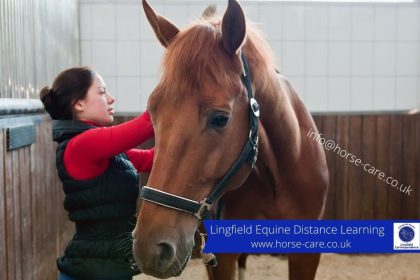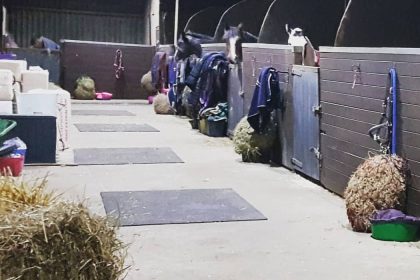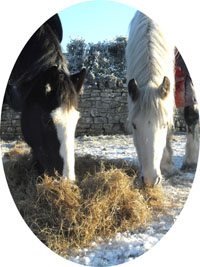Riding in Winter is often a little tricky, especially if you have any of the following situations. Do you have:
A new horse? A horse which gets a bit excited? A horse which is a bit nervous? A horse which is too fresh or sprightly in Winter? Limited turnout? For many, riding out’ or ‘hacking’ away from the yard – even if it is just round the block on the road – can be a nightmare.
Wouldn’t it be heaven to have a horse which is almost as relaxed to ride out in Winter as it is in Summer?
If it’s a bit scary to ride on the road in Winter – which in UK is unavoidable for most of us – we have some ideas which could fix it. Wouldn’t it be be nice to be relaxed about riding out? More importantly, wouldn’t it be good to get your horse relaxed!
An ‘out ride’ or hack, or an exercise session off the property, introduces so many more experiences into the riding mix. One of the main issues with Winter riding is the lack of turnout combined with the feed not being adjusted sufficiently to fit that lack of turnout. Many adjust the feed, but not nearly enough and let’s be clear here – we are not talking about reducing the amount of feed – the adjustment has nothing to do with that. It is the TYPE of food that needs adjustment.
If your horse can be a bit ‘over the top’ when riding out in Winter you absolutely MUST get the feeding right. Make no mistake, it is the feeding and lack of turnout which is the cause of the horse being ‘over the top’ – it is not just because the weather is cold!
If you prepare well however, and have these ‘pre hacking / riding on the road plans’ in place, you may find it easier when the time comes. These plans are one way to build towards more confident ‘out rides’ and hacking BEFORE you start riding on the road or along that bridle path. Preparing, will help you have rides which are successful and enjoyable for both of you. Make this your Autumn project – you could begin before you start bringing your horse in overnight or stable him/her for slightly longer than in the Summer.
Step 1. Is the most important of all. Reduce the energy levels in your horse’s feed.
Consider first your exercise / work level:
If all you do is hack or ride in the school most days for an hour or less, you absolutely must reduce the energy level in your horse’s feed to a ‘maintenance diet’.
Step Counter: It is important to realise that if your horse were able to wear a step counter, the amount of exercise mentioned above would invariably be less than he/she would do when turned out in the field in Summer.
If therefore, you are reducing the horse’s exercise because you cannot turn out – why would you give more energy food than is required for that amount of exercise.
It is like giving children lots of sweets and fizzy drinks for breakfast and expecting them to always sit quietly in the classroom.
Even if your horse needs more weight you can still feed more food if you need to – but that food must be an energy level equivalent to a maintenance diet. We all know or should do, that hay/haylage/fibre is the basic and main weight gainer in their diet. It is the basics first principle – feed more fibre – hay / haylage etc. (if you feed anything else for weight gain you MUST check the DE – digestible energy – levels are low enough).
It is a feed which maintains the body, the bodily functions, the fat, the muscles and general body fitness (this is not the same as ‘sports’ fitness) at a good level for the amount of exercise the horse is undertaking.
For some horses who do not need energy (and who are undertaking little exercise over and above the daily turnout regime and occasional walk around the block or schooling session), this might mean giving a ‘pretend’ feed – some call it a placebo feed. It is food of some sort in a bucket which makes the horse happy and feels to him like a feed.
Whatever is fed, must of course contain a good all round vitamin and mineral supplement or one of the modern balancers which is simply a carrier for the supplements and has vitually nil / very low DE levels.
Local competition? If you enter the occasional competition then MAYBE you might need, on the day before, to give a tiny bit of extra energy – but honestly consider how much energy is used by driving to a show and doing a jumping round or a dressage test – not very much. It would probably be equivalent to or less than an hour’s hacking or an hour in the school.
If you are not sure what to feed, speak to an independent equine nutritionist on the phone. It may cost £30-50 for a consultation but isn’t that worth it for a Winter of happy riding? (Let’s face it, it’s less than a set of shoes or a couple of bags of feed.)
Prepare for that call by making a list of: a) What riding you do on a daily/weekly basis – and be truthful. b) What turnout your horse gets every day and week. c) Learning how to describe your horse – They do not want the whole history – they just need the basics initially.
Simply include, Age, type, height, and current body weight situation along with the amount of work/exercise being undertaken
Write it down. Example of descriptions could include 14 yr old 15.3 TB /sports horse/ Irish / Connemara / part heavy horse / cob type. Medium weight type / TB type, and a tiny bit overweight a good doer /drops weight in Winter. Laid back in Summer – can be fresh or sprightly in Winter.
Our recommended nutritionist would be Claire MacLeod – many years of experience. Best of all in our opinion is that Clare uses ordinary every day language and is intent on busting the myths surrounding nutrition. An alternative is to take a serious feeding and nutrition course – not just a pop in and out course that could be found freely on the internet today – but a detailed course to provide you with genuine in depth and all round knowledge on the subject. A course which explains in plain English why you feed specific feeds and what the results will be. A example is the Lingfield Equine Feeding & Nutrition course or the all round Level 1 Plus Equine Management course.
So having got the feed right or have a plan in place for it, you can move on to Step 2.
Step 2. Start your project by doing some really solid groundwork first. Don’t ignore this bit even if you have owned your horse for some time and you believe communications between you are good. This time for this project, start from Step 1
How good is your communication? Is your horse confident? Is he or she really connected and responsive to you?
Can you lead your horse at walk, trot, stop and back up easily? Can you cross a tarp or board on the ground when leading? or over some poles? Can you ask him or her to yield to a request to move his/her hindquarters over easily and politely or to back up a step or two?
Be sure your horse responds to your voice requests – (we prefer ‘requests’ to ‘commands’). Examples: ‘walk on’, ‘stand’, ‘steady’, ‘back’ or ‘back up‘, ‘over’ or ‘move over’. ‘foot’ or ‘foot please’ is another which should be used regularly when picking out feet – (rather than the painful fetlock squeeze used by so many poorly trained novices today). Just because you are bending down to pick the foot up, does not mean you have to shout this out – your horse will hear your quiet request providing you have a built a good relationship and good communication skills.
These 6 requests for movement are so commonly asked for it is unusual that not everyone uses them out loud. We all understand the use of voice commands for dogs – so why not be more communicative orally with your horse. They should not be LOUD requests – your horse has excellent hearing so do not shout or raise your voice. Keep it low and calm. Your horse knows your voice. Your voice will give confidence – use it well.
Be sure you use exactly the same words and the same tone and level of volume each time you use that request. If when things are a bit scary, you use the request ‘steady’, be sure to keep the tone and level of your voice the same – even if you are stressed – don’t get louder or higher. Build your voice requests into your project and listen to how you say them – you could even record them occasionally when you are using them to see how it sounds. It is important they sound the same each time – you will use them on the ground and when riding. Your horse does not understand the meaning of the ACTUAL word but he does understand the sound of it. This is part of the project is really important. Watch your horse’s ears, study his reactions.
Step 3: Have you been on regular walks in hand around the yard, fields and paddocks, in the school and up and down the drive to the road etc.
Surprisingly – some horses who lack confidence get anxious as soon as you lead them out of the field. Stop, for a moment, look and actally see what happens with your horse in Winter or any time when it is your riding time. If there is any anxiousness (look at the eyes, nostrils, stance) start right there before you get to riding. Do lots of in hand short walking on the property until your horse feels less anxious and relaxed about being led. In some circumstances and with some horses, it might be more about them worrying about going on a hack.
If you are able to, hand graze very near the road gateway – it can help especially if you totally ignore the traffic rather than making a big deal out of it. Getting the horse re-accustomed in Winter to the sounds of noisy tractors, busses, lorries and motorbikes can be really helpful. Your voice requests may come in useful in such situations. Your horse however, may not need calming so no need to use calming strokes/pats and language if it is not needed. Don’t just stand there on your phone however, the object of the exercise is to be aware of your horse and how he / she reacts.
Step 4: Whichever route you are taking – on the property, or on a hack or round the block, take the same route until your horse is confident.
Only then should you consider extending the route or changing it or doing it the other way around
Practise leading from both sides (because on the road you will need to be on the horses right)
Practise leading by being at the horses shoulder which is more akin to the riders position or even from behind by long reining on the property so that your horse gets confident to go first. Ask a friend to walk beside the horse to begin with if necessary.
When hacking on the road and bridleways, take or go with a friend with a confident horse if possible
Accompanying a friend with a confident horse as company at first will greatly help your insecure horse.
Step 5: Make sure you have set up some good riding basics in place at home
Check your basic communication when riding: can you stop without reins – using your voice and weight? Do you get a good forward response from your horse via your leg AND your voice?
Can you at least walk and trot calmly at home?
Can your horse pass over tarps or odd changes of surfaces and road surfaces, man hole covers, poles, at home? If he can’t do it at home, you will have difficulties on roads and hacks.
Step 6: Start Very short mini rides at home:
Once your horse is confident with those walks, you can start to do mini-exploration rides around the property if possible. Ride the same small loop about 3 times within 30 minutes
Step 7: Expand your rides:
Once your horse is confident on mini-rides at home, you can gradually expand.
Just because you have had your horse for some years and do not feel the need to attempt such a project, it is worth trying and getting to grips with this step by step approach so that you both get to know each other better again. Let’s all enjoy Winter riding as much as Summertime riding !
Go on easy out rides at first – especially with a new horse or at first each Winter. Riding right away through a village will be challenging, especially for a new or young horse. Choose easy routes where you know there won’t be much traffic (vehicles, bikes, other horses)
Go on out rides with company if possible at first.
Choose your company wisely. It needs to be a horse that’s calm and friendly. This will give your horse a lot of confidence to start out.
If you are alone, do in hand walk & ride: you ride when your horse feels good, you get off and walk when necessary – providing of course that you can find somewhere safe to mount easily.
Go on out rides often – not just once in a blue moon
We can’t expect a horse to get better with a difficult topic if we don’t practise regularly. Repetition is what creates confidence.
Gradually expand out rides in duration and distance as yours and your horse’s confidence grows
Give your horse grazing breaks when out on a hack – explain to your friend that this is a project and your aim is to get your horse calmer. Stopping to graze has a calming effect and makes riding feel more like a pleasure for your horse – he or she is also getting a treat – in the same way that you are when you ride a relaxed horse.
And here are a few more golden rules:
Don’t push your horse past his or her thresholds when things get scary – if it is safe and you will feel safer – get off and lead.
Don’t canter just for fun! This is just going to make your horse hot / excited.
Don’t keep trotting when your horse starts rushing and is tense – it is not going to help him or her to remain calm!
Get OFF if your horse gets excited! Your safety is priority number one but be sure you and your horse are safe to do so.
Let us know how you get on and if this was useful, or if you have any other tips for riders with new horses or with Winter riding issues. mail to: info@horse-care.co.uk



Receive latest news and industry insights straight to your inbox.